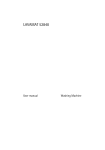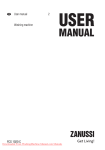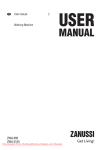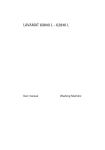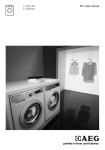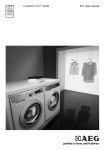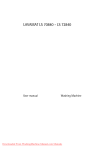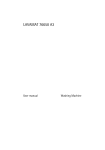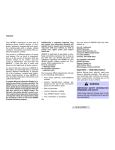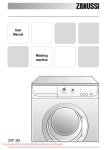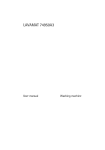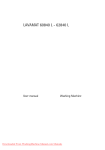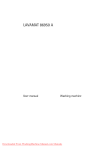Download AEG LAVAMAT 52840 User manual
Transcript
LAVAMAT 52840 User manual Washing Machine Downloaded From WashingMachine-Manual.com Manuals 2 Contents Thank you for choosing one of our high-quality products. To ensure optimal and regular performance of your appliance please read this instruction manual carefully. It will enable you to navigate all processes perfectly and most efficiently. To refer to this manual any time you need to, we recommend you to keep it in a safe place. And please pass it to any future owner of the appliance. We wish you much joy with your new appliance. CONTENTS OPERATING INSTRUCTIONS 3 SAFETY INFORMATION 3 General safety 3 Installation 3 Use 4 Child Safety 4 PRODUCT DESCRIPTION 5 Detergent dispenser drawer 6 CONTROL PANEL 6 Indicator pilot lights (7) 7 FIRST USE 7 DAILY USE 7 Load the laundry 7 Measure out the detergent and the fabric softener 7 Select the required programme by means of programme selector dial (1) 8 Select the SPIN speed or the RINSE HOLD option (Button 2) 8 Programme option button 9 Select the STAIN option (Button 3) 9 Select the SUPER QUICK option (Button 4) 9 Select the START/PAUSE (Button 5) 9 Select the DELAY START (Button 6) 9 Select an additional rinse 10 Altering an option or a running programme 10 Interrupting a programme 10 Cancelling a programme 10 Opening the door after the programme has started 10 At the end of the programme 11 WASHING PROGRAMMES 11 HELPFUL HINTS AND TIPS Sorting out the laundry Before loading the laundry Removing stains Detergents and additives Quantity of detergent to be used Degrees of water hardness CARE AND CLEANING Descaling After each wash Maintenance wash External cleaning Detergent dispenser drawer Washing drum Door seal Drain pump Cleaning the water inlet filters Emergency emptying out Frost precautions WHAT TO DO IF… TECHNICAL DATA CONSUMPTION VALUES INSTALLATION INSTRUCTIONS INSTALLATION Unpacking Positioning and levelling Water inlet Water drainage In the interest of the environment ELECTRICAL CONNECTION ENVIRONMENT CONCERNS Packaging materials Ecological hints Downloaded From WashingMachine-Manual.com Manuals 14 14 14 14 14 15 15 15 15 15 16 16 16 16 17 17 19 20 20 20 23 24 24 24 24 27 27 28 30 30 31 31 31 Subject to change without notice Safety information 3 OPERATING INSTRUCTIONS SAFETY INFORMATION Read carefully & keep for future reference. • The safety of Your appliance complies with the industry standards and with legal requirements on the safety of appliances. However, as manufacturers, we feel it is our duty to provide the following safety notes. • It is most important that this instruction book should be retained with the appliance for future reference. Should the appliance be sold or transferred to another owner, or should you move house and leave the appliance, always ensure that the book is supplied with the appliance in order that the new owner can get to know the functioning of the appliance and the relevant warnings. • You MUST read them carefully before installing or using the appliance. • Before first starting up, check the appliance for any damage incurred during transport. Never connect up a damaged appliance . If parts are damaged, contact your supplier. • If the appliance is delivered in the winter months when there are minus temperatures. Store it at room temperature for 24 hours before using for the first time. General safety • It is dangerous to alter the specifications or attempt to modify this product in any way. • During high temperature wash programmes the door glass may get hot. Do not touch it! • Make sure that small pets and children do not climb into the drum. To avoid this, please check into the drum before using. • Any objects such as coins, safety pins, nails, screws, stones or any other hard, sharp material can cause extensive damage and must not be placed into the machine. • Only use the advised quantities of fabric softener and detergent. Damage to the fabric can ensue if you over-fill. Refer to the manufacturer’s recommendations of quantities. • Wash small items such as socks, laces, washable belts etc in a washing bag or pillow case as it is possible for such items to slip down between the tub and the inner drum. • Do not use your washing machine to wash articles with whalebones, material without hems or torn material. • Always unplug the appliance and turn off the water supply after use, cleaning and maintenance. • Under no circumstances should you attempt to repair the machine yourself. Repairs carried out by inexperienced people may cause injury or serious malfunctioning. Contact your local Service Centre. Always insist on genuine spare parts. Installation • This appliance is heavy. Care should be taken when moving it. • When unpacking the appliance, check that it is not damaged. If in doubt, do not use it and contact the Service Centre. Downloaded From WashingMachine-Manual.com Manuals 4 Safety information • All packing and transit bolts must be removed before use. Serious damage can occur to the product and to property if this is not adhered to. See relevant section in the user manual. • After having installed the appliance, check that it is not standing on the inlet and drain hose and the worktop is not pressing the electrical supply cable against the wall. • If the machine is situated on a carpeted floor, please adjust the feet in order to allow air to circulate freely under the appliance. • Always be sure, that there is no water leakage from hoses and their connections after the installation. • If the appliance is installed in a location subject to frost, please read the “dangers of freezing” chapter. • Any plumbing work required to install this appliance should be carried out by a qualified plumber or competent person. • Any electrical work required to install this appliance should be carried out by a qualified electrician or competent person. Use • This appliance is designed for domestic use. It must not be used for purposes other than those for which it was designed. • Only wash fabrics which are designed to be machine washed. Follow the instructions on each garment label. • Do not overload the appliance. See the Washing Programme Table. • Before washing, ensure that all pockets are empty and buttons and zips are fastened. Avoid washing frayed or torn articles and treat stains such as paint, ink, rust, and grass before washing. Underwired bras must NOT be machine washed. • Garments which have been in contact with volatile petroleum products should not be machine washed. If volatile cleaning fluids are used, care should be taken to ensure that the fluid is removed from the garment before placing in the machine. • Never pull the power supply cable to remove the plug from the socket; always take hold of the plug itself. • Never use the appliance if the power supply cable, the control panel, the working surface or the base are damaged so that the inside of the washing machine is accessible. Child Safety • This appliance is not intended for use by person (including children) with reduced physical sensory or mental capabilities or lack of experience and knowledge unless they have been given supervision or instruction concerning use of the appliance by a person responsible for their safety. • Children should be supervised to ensure that they do not play with the appliance. • The packaging components (e.g. plastic film, polystyrene) can be dangerous to children danger of suffocation! Keep them out of children's reach. • Keep all detergents in a safe place out of children’s reach. Downloaded From WashingMachine-Manual.com Manuals Product description 5 • Make sure that children or pets do not climb inside the drum. To prevent children or pets becoming trapped inside the drum the machine incorporates a special feature. To activate this device, rotate the button (without pressing it) inside the door clockwise until the groove is horizontal. If necessary use a coin. To disable this device and restore the possibility of closing the door, rotate the button anticlockwise until the groove is vertical. PRODUCT DESCRIPTION Your new appliance meets all modern requirements for effective treatment of laundry with low water, energy and detergent consumption. The ECO valve system allows total use of detergent and reduces water consumption so saving energy. 2 1 3 4 6 1 Detergent dispenser drawer 2 Control panel 3 Door opening handle 4 Rating plate 5 Drain pump 6 Adjustable feet Downloaded From WashingMachine-Manual.com Manuals 5 6 Control panel Detergent dispenser drawer Compartment for prewash phase or stain remover. The prewash detergent is added at the beginning of the wash programme. The stain remover is added during the STAIN-Action phase in the main wash. Compartment for powder or liquid detergent used for main wash. Compartment for liquid additives (fabric softener, starch). Follow the product manufacturer’s recommendations on quantities to use and do not exceed the «MAX» mark in the detergent dispenser drawer. Any fabric softener or starching additives must be poured into the compartment before starting the wash programme. CONTROL PANEL Below is a picture of the control panel. It shows the programme selector dial as well as the buttons and the pilot lights. These are presented by relevant numbers on the following pages. 2 1 1 2 3 4 5 6 7 Programme selector dial SPIN button STAIN button SUPER QUICK button START/PAUSE button DELAY START button Indicator pilot lights Symbols: Rinse Hold, Handwash, Cold Downloaded From WashingMachine-Manual.com Manuals 3 4 5 6 7 First use 7 Indicator pilot lights (7) After having pressed the button 5, the WASHING pilot light (7.1) comes on. When the pilot light 7.1 comes on this means that the machine is operating. When the programme has finished, the END pilot light (7.2) comes on. When the appliance is performing additional rinses the EXTRA RINSE pilot light (7.3) comes on. To add an additional rinse, please see «Select an additional rinse». FIRST USE • Ensure that the electrical and water connections comply with the installation instructions. • Remove the polystyrene block and any material from the drum. • Pour 2 litres of water into the main wash compartment of the detergent drawer in order to activate the ECO valve. Then run a cotton cycle at the highest temperature without any laundry in the machine, to remove any manufacturing residue from the drum and tub. Pour 1/2 a measure of detergent into the main wash compartment and start the machine. DAILY USE Load the laundry 1. 2. Open the door by carefully pulling the door handle outwards. Place the laundry in the drum, one item at a time, shaking them out as much as possible. Close firmly the door. You must hear a click during closing. WARNING! Do not embed the laundry between the door and the rubber joint. Measure out the detergent and the fabric softener Your new appliance was designed to reduce water, energy and detergent consumption. Downloaded From WashingMachine-Manual.com Manuals 8 Daily use 1. Pull out the dispenser drawer until it stops. Measure out the amount of detergent required, pour it into the main wash compartment and, if you wish to carry out the prewash phase or to perform the stain function, pour the detergent or the stain remover into the . compartment marked 2. If required, pour fabric softener into the compartment marked (the amount used must not exceed the MAX mark in the drawer). Close the drawer gently. Select the required programme by means of programme selector dial (1) You can choose the right programme for any type of laundry following the descriptions on the washing programme tables (see «Washing Programmes»). Turn the programme selector dial to the required programme. The programme selector determines the type of washing cycle (e.g. water level, drum movement, number of rinses) and the washing temperature according to the type of laundry. The pilot light of button 5 starts blinking. to Reset proThe selector dial can be turned either clockwise or anticlockwise. Position gramme/ Switching OFF of the machine. , to At the end of the programme the selector dial must be turned to position switch the machine off. If you turn the programme selector dial to another programme when the machine is working, the yellow pilot light of button 5 will blink 3 times to indicate a wrong selection. The machine will not perform the new selected programme. Select the SPIN speed or the RINSE HOLD option (Button 2) When the required programme has been selected, your appliance automatically proposes the maximum spin speed provided for that programme. Downloaded From WashingMachine-Manual.com Manuals Daily use 9 Press the button 2 repeatedly to change the spin speed, if you want your laundry to be spun at a speed different from the one proposed by the washing machine. The relevant light will light up. RINSE HOLD : by selecting this option the water of the last rinse is not emptied out to prevent the fabrics from creasing. When the programme has finished the pilot light 7.2 goes on, the pilot light of button 5 and the pilot light (7.1) are off and the door is blocked to indicate that the water must be emptied out. To empty the water out please read chapter «At the end of the programme». Programme option button Depending on the programme, different functions can be combined. These must be selected after choosing the desired programme and before depressing the button 5 . When these buttons are pressed, the corresponding pilot lights come on. When they are pressed again, the pilot lights go out. If an incorrect option is selected, the yellow pilot light of the button 5 blinks for 3 times. For the compatibility among the washing programmes and the options see chapter «Washing Programmes». Select the STAIN option (Button 3) Select this option to treat heavily soiled or stained laundry with stain remover (extended main wash with time optimised stain action phase). The relevant light will light up. This option is not available with a temperature lower than 40°C. CAUTION! If you wish to perform a programme with the stain option, pour stain remover into com. partment Select the SUPER QUICK option (Button 4) By pressing this button, the relevant pilot light comes on and the washing duration will be reduced to wash lightly soiled laundry. This option is suitable for items that have been used or worn for a short time. Select the START/PAUSE (Button 5) To start the selected programme, press the button 5 ; the corresponding red pilot light stops flashing. The pilot light 7.1 is on to indicate that the appliance starts operating and the door is locked. To interrupt a programme which is running, press the button 5 : the corresponding red pilot light starts blinking. To restart the programme from the point at which it was interrupted, press the button 5 again. If you have chosen a delayed start, the machine will begin the countdown. Select the DELAY START (Button 6) Before you start the programme, if you wish to delay the start, press the button 6 repeatedly, to select the desired delay. The relevant light illuminates. This button makes it possible to delay the starting of the washing programme by 3, 6 and 9 hours. Downloaded From WashingMachine-Manual.com Manuals 10 Daily use You must select this option after you have set the programme and before you press the button 5. You can cancel the delay time at any moment, before you press the button 5. If the button 5 has already been pressed: • set the washing machine to PAUSE by pressing the button 5; • press the button 6 once, the light relevant to the selected delay goes off; • press the button 5 again to start the programme. Important! • The selected delay can be changed only after selecting the washing programme again. • The door will be locked throughout the delay time. If you need to open the door, you must first set the washing machine to PAUSE by pressing the button 5 and then wait some minutes. After you have closed the door, press the button 5 again. The DELAY START can not be selected with DRAIN programme. Select an additional rinse This appliance is designed for saving water. However, for people with a very delicate skin (allergic to detergents) it may be necessary to rinse the laundry using an extra quantity of water (extra rinse). Press simultaneously button 2 and 3 for a few seconds: the light 7.3 comes on. This function stays permanently on. To remove it press the same buttons again until the light 7.3 goes off. Altering an option or a running programme It is possible to change any option before the programme carries it out. Before you make any change, you must pause the washing machine by pressing the button 5. Changing a running programme is possible only by resetting it. Turn the programme seand then to the new programme position. Start the new programme by lector dial to pressing the 5 button again. The washing water in the tub will not emptied out. Interrupting a programme Press the button 5 to interrupt a programme which is running, the corresponding light starts blinking. Press the button again to restart the programme. Cancelling a programme Turn the selector dial to new programme. to cancel a programme which is running. Now you can select a Opening the door after the programme has started First set the machine to pause by pressing the button 5. After some minutes the door can be opened. If the door remains locked, this means that the machine is already heating, that the water level is above the bottom edge of the door. In this case the door can not be opened. If you cannot open the door but you need to open it you have to switch the machine off by . After about a few minutes the door can be opened (pay turning the selector dial to attention to the water level and temperature!). Downloaded From WashingMachine-Manual.com Manuals 11 After closing the door, it is necessary to select the programme and options again and to press button 5. At the end of the programme The machine stops automatically. The pilot light of button 5 and pilot light 7.1 go off. The phase light 7.2 goes on. If a programme or an option that ends with water still in the tub has been selected, the relative pilot light remains lit, the phase light 7.2 goes on, the door remains locked to indicate that the water must be emptied out before opening the door. To empty the water out: • turn the programme selector dial to • select the DRAIN or SPIN programme • reduce the spin speed if needed, by means of the relevant button • press button 5 • when the programme has finished only the pilot light 7.2 comes on. to switch the machine off. Remove the laundry Turn the programme selector dial to from the drum and carefully check that the drum is empty. If you do not intend to carry out another wash, close the water tap. Leave the door open to prevent the formation of mildew and unpleasant smells. Stand by: once the programme has finished after a few minutes the energy saving system is enabled with the pilot lights switched on. By pressing any button the appliance will come out of the energy saving status. WASHING PROGRAMMES Programme - Maximum and Minimum Temperature Cycle Description - Maximum Spin Speed - Maximum Fabrics Load - Type of Laundry Options COTTONS/LINEN 95°- 30° Main wash - Rinses - Long spin Maximum spin speed at 1200 rpm Max. load 6 kg - Red. load 3 kg For white and fast coloured cotton (heavily and normally soiled items). SPIN reduction / RINSE HOLD, STAIN1), EXTRA RINSE, TIME SAVING2) COTTONS + PREWASH 60°- 40° Prewash - Main wash - Rinses - Long spin Maximum spin speed at 1200 rpm Max. load 6 kg - Red. load 3 kg White or coloured cottons with prewash phase (heavily soiled items). SPIN reduction / RINSE HOLD, EXTRA RINSE, TIME SAVING2) Downloaded From WashingMachine-Manual.com Manuals Detergent Compartment 3) 12 Washing programmes Programme - Maximum and Minimum Temperature Cycle Description - Maximum Spin Speed - Maximum Fabrics Load - Type of Laundry Options SYNTHETICS 60°- 30° Main wash - Rinses - Short spin Maximum spin speed at 1200 rpm Max. load 3 kg - Red. load 1,5 kg Synthetic or mixed fabrics: underwear, coloured garments, non-shrink shirts, blouses. SPIN reduction / RINSE HOLD, STAIN1), EXTRA RINSE, TIME SAVING2) EASY IRON PLUS 40° Main wash - Rinses - Short spin Maximum spin speed at 1200 rpm Max. load 1 kg Synthetic fabrics to be gentle washed and spun. Selecting this programme the laundry is gently washed and spun to avoid any creasing. In this way ironing is easier. Furthermore the machine will perform additional rinses. SPIN reduction / RINSE HOLD, EXTRA RINSE DELICATES 40°- 30° Main wash - Rinses - Short spin Maximum spin speed at 1200 rpm Max. load kg 3 - Red. load kg 1,5 Delicate fabrics: acrylics, viscose, polyester. SPIN reduction / RINSE HOLD , STAIN1), EXTRA RINSE, TIME SAVING2) WOOL PLUS SILK 30°- Cold Main wash - Rinses - Short spin Maximum spin speed at 1200 rpm Max. load 2 kg; (Silk max. load: 1 kg) A special washing programme for machine washable wool and silk items as well as for hand washable woollens and silk fabrics with handwash label.Note : A single or bulky item may cause imbalance. If the appliance doesn’t perform the final spin phase, add more items, redistribute the load manually and then select the spinning programme. SPIN reduction / RINSE HOLD DELICATE RINSES Rinses - Short spin Maximum spin speed at 1200 rpm Max. load 6 kg With this programme it is possible to rinse and spin cotton garments which have been washed by hand. The machine performs some rinses, followed by a final spin. SPIN reduction / RINSE HOLD , EXTRA RINSE Downloaded From WashingMachine-Manual.com Manuals Detergent Compartment Washing programmes Programme - Maximum and Minimum Temperature Cycle Description - Maximum Spin Speed - Maximum Fabrics Load - Type of Laundry Options 13 Detergent Compartment DRAIN Draining of water Max. load 6 kg For emptying out the water of the last rinse in programmes with the Rinse Hold option selected. SPIN Drain and long spin Maximum spin speed at 1200 rpm Max. load 6 kg Separate spin for hand washed cotton garments and after programmes with the Rinse Hold option selected. Before selecting this programme the selector dial . You can choose the spin must be turned to speed by pressing the relevant button to adapt it to the fabrics to be spun. SPIN reduction REFRESH 30° Main wash - Rinses - Short spin Maximum spin speed at 1200 rpm Max. load 2 kg This programme may be used for a quick washing of sport items or cotton and synthetic items , lightly soiled or worn once. SPIN reduction ECONOMY 60° - 40° Main wash - Rinses - Long spin Maximum spin speed at 1200 rpm Max. load 6 kg White and fast coloured cotton. This programme can be selected for slightly or normally soiled cotton items. The temperature will decrease and the washing time will be extended. This allows to obtain a good washing efficiency so saving energy. SPIN reduction / RINSE HOLD, STAIN, EXTRA RINSE / OFF For cancelling the programme which is running or to switch the machine off . 1) This option is not available with a temperature lower than 40°C. 2) If you select the Super Quick option by pressing button 5, we recommend that you reduce the maximum load as indicated. (Red. load = reduced load). Full loading is possible however with somewhat reduced cleaning results. 3) If using liquid detergents, a programme without prewash must be selected. Downloaded From WashingMachine-Manual.com Manuals 14 Helpful hints and tips HELPFUL HINTS AND TIPS Sorting out the laundry Follow the wash code symbols on each garment label and the manufacturer’s washing instructions. Sort the laundry as follows: whites, coloureds, synthetics, delicates, woollens. Before loading the laundry Never wash whites and coloureds together. Whites may lose their «whiteness» in the wash. New coloured items may run in the first wash; they should therefore be washed separately the first time. Button up pillowcases, close zip fasteners, hooks and poppers. Tie any belts or long tapes. Remove persistent stains before washing. Rub particularly soiled areas with a special detergent or detergent paste. Treat curtains with special care. Remove hooks or tie them up in a bag or net. Removing stains Stubborn stains may not be removed by just water and detergent. It is therefore advisable to treat them prior to washing. Blood: treat fresh stains with cold water. For dried stains, soak overnight in water with a special detergent then rub in the soap and water. Oil based paint: moisten with benzine stain remover, lay the garment on a soft cloth and dab the stain; treat several times. Dried grease stains: moisten with turpentine, lay the garment on a soft surface and dab the stain with the fingertips and a cotton cloth. Rust: oxalic acid dissolved in hot water or a rust removing product used cold. Be careful with rust stains which are not recent since the cellulose structure will already have been damaged and the fabric tends to hole. Mould stains: treat with bleach, rinse well (whites and fast coloureds only). Grass: soap lightly and treat with bleach (whites and fast coloureds only). Ball point pen and glue: moisten with acetone1), lay the garment on a soft cloth and dab the stain. Lipstick: moisten with acetone as above, then treat stains with methylated spirits. Treat any residual marks with bleach. Red wine: soak in water and detergent, rinse and treat with acetic or citric acid, then rinse. Treat any residual marks with bleach. Ink: depending on the type of ink, moisten the fabric first with acetone1), then with acetic acid; treat any residual marks on white fabrics with bleach and then rinse thoroughly. Tar stains: first treat with stain remover, methylated spirits or benzine, then rub with detergent paste. Detergents and additives Good washing results also depend on the choice of detergent and use of the correct quantities to avoid waste and protect the environment. Although biodegradable, detergents contain substances which, in large quantities, can upset the delicate balance of nature. 1) do not use acetone on artificial silk Downloaded From WashingMachine-Manual.com Manuals Care and cleaning 15 The choice of detergent will depend on the type of fabric (delicates, woollens, cottons, etc.), the colour, washing temperature and degree of soiling. All commonly available washing machine detergents may be used in this appliance: • powder detergents for all types of fabric • powder detergents for delicate fabrics (60°C max) and woollens • liquid detergents, preferably for low temperature wash programmes (60°C max) for all types of fabric, or special for woollens only. The detergent and any additives must be placed in the appropriate compartments of the dispenser drawer before starting the wash programme. If using liquid detergents, a programme without prewash must be selected. Your appliance incorporates a recirculation system which allows an optimal use of the concentrated detergent. Follow the product manufacturer’s recommendations on quantities to use and do not exceed the «MAX» mark in the detergent dispenser drawer. Quantity of detergent to be used The type and quantity of detergent will depend on the type of fabric, load size, degree of soiling and hardness of the water used. Follow the product manufacturers’ instructions on quantities to use. Use less detergent if: • you are washing a small load • the laundry is lightly soiled • large amounts of foam form during washing. Degrees of water hardness Water hardness is classified in so-called “degrees” of hardness. Information on hardness of the water in your area can be obtained from the relevant water supply company, or from your local authority. If the water hardness degree is medium or high we suggest you to add a water softener following always the manufacturer’s instructions. When the degree of hardness is soft, readjust the quantity of the detergent. CARE AND CLEANING You must DISCONNECT the appliance from the electricity supply, before you can carry out any cleaning or maintenance work. Descaling The water we use normally contains lime. It is a good idea to periodically use a water softening powder in the machine. Do this separately from any laundry washing, and according to the softening powder manufacturer's instructions. This will help to prevent the formation of lime deposits. After each wash Leave the door open for a while. This helps to prevent mould and stagnant smells forming inside the appliance. Keeping the door open after a wash will also help to preserve the door seal. Downloaded From WashingMachine-Manual.com Manuals 16 Care and cleaning Maintenance wash With the use of low temperature washes it is possible to get a build up of residues inside the drum. We recommend that a maintenance wash be performed on a regular basis. To run a maintenance wash: • The drum should be empty of laundry. • Select the hottest cotton wash programme. • Use a normal measure of detergent, must be a powder with biological properties. External cleaning Clean the exterior cabinet of the appliance with soap and water only, and then dry thoroughly. Do not use methylated spirits, solvents or similar products to clean the cabinet. Detergent dispenser drawer The detergent dispenser drawer should be cleaned regularly. 1. Remove the detergent dispenser drawer by pulling it firmly. 2. Remove the conditioner insert from the middle compartment. 3. Clean all parts with water. 4. Put the conditioner insert in as far as it will go, so that it is firmly in place. 5. 6. Clean all parts of the washing machine, especially the nozzles in the top of the washing-in chamber, with a brush. Insert the detergent dispenser drawer in the guide rails and push it in. Washing drum Rust deposits in the drum may occur due to rusting foreign bodies in the washing or tap water containing iron. Do not clean the drum with acidic descaling agents, scouring agents containing chlorine or iron or steel wool. 1. 2. Remove any rust deposits on the drum with a cleaning agent for stainless steel. Run a washing cycle without any washing to clean off any cleaning agent residues. Downloaded From WashingMachine-Manual.com Manuals Care and cleaning 17 Programme: Short Cotton Programme at maximum temperature and add approx. 1/4 measuring cup of detergent. Door seal Check from time to time the door seal and objects that could be trapped in the fold. Drain pump The pump should be inspected regularly and particularly if: • the appliance does not empty and/or spin; • the appliance makes an unusual noise during draining due to objects such as safety pins, coins etc. blocking the pump; • a problem with water draining is detected (see chapter “What to do if...” for more details). WARNING! Before opening the pump door, switch the appliance off remove the mains plug from the socket. Proceed as follows: 1. Unplug the appliance. 2. If necessary wait until the water has cooled down. 3. Open the pump door. 4. Pull flap forward to remove. 5. Place a container close to the pump to collect any spillage. 6. Pull out the emergency emptying hose, place it in the container and remove its cap. Downloaded From WashingMachine-Manual.com Manuals 18 Care and cleaning 7. 8. When no more water comes out, unscrew the pump cover by turning it anti-clockwise and remove the filter. Use pliers, if necessary. Always keep a rag nearby to dry up any water spillages when removing the cover. Clean the filter under a tap, to remove any traces of fluff. Remove foreign bodies and fluff from the filter seat and from the pump impeller. 9. Check carefully whether the pump impeller rotates (it rotates jerkily). If it doesn’t rotate, please contact your Service Centre. 10. Put the cap back on the emergency emptying hose and place the latter back in its seat. 11. Replace the filter into the pump by inserting it correctly into the special guides. Screw the pump cover firmly by turning it clockwise. 12. Refit the flap and close the pump door. WARNING! When the appliance is in use and depending on the programme selected there can be hot water in the pump. Never remove the pump cover during a wash cycle, always wait until the appliance has finished the cycle, and is empty. When refitting the pump cover, ensure it is securely re-tightened so as to stop leaks and young children being able to remove it. Downloaded From WashingMachine-Manual.com Manuals Care and cleaning 19 Cleaning the water inlet filters If the appliance doesn't fill, it takes a long time to fill with water, the starting button blinks yellow or the display (if available) shows the relevant alarm (see chapter "What to do if..." for more details), check if the water inlet filters are blocked . To clean the water inlet filters: 1. Turn off the water tap. 2. Unscrew the hose from the tap. 3. Clean the filter in the hose with a stiff brush. 4. Screw the hose back onto the tap. Make sure the connection is tight. 5. 6. 7. 8. Unscrew the hose from the machine. Keep a towel nearby because some water may flow. Clean the filter in the valve with a stiff brush or with the piece of cloth. Screw the hose back to the machine and make sure the connection is tight. Turn on the water tap. Downloaded From WashingMachine-Manual.com Manuals 20 What to do if… Emergency emptying out If the water is not discharged, proceed as follows to empty out the machine: 1. pull out the plug from the power socket; 2. close the water tap; 3. if necessary, wait until the water has cooled down; 4. open the pump door; 5. place a bowl on the floor and place the end of the emergency emptying hose into the bowl. Remove its cap. The water should drain by gravity into the bowl. When the bowl is full, put the cap back on the hose. Empty the bowl. Repeat the procedure until water stops flowing out; 6. clean the pump if necessary as previously described; 7. replace the emergency emptying hose in its seat after having plugged it; 8. screw the pump again and close the door. Frost precautions If the machine is installed in a place where the temperature could drop below 0°C, proceed as follows: 1. close the water tap and unscrew the water inlet hose from the tap; 2. place the end of the emergency emptying hose and that of the inlet hose in a bowl placed on the floor and let water drain out; 3. screw the water inlet hose back on and reposition the emergency emptying hose after having put the cap on again. By doing this, any water remaining in the machine is removed, avoiding ice forming and consequently damage to the appliance. When you use the machine again, make sure that the ambient temperature is above 0°C. Every time you drain the water through the emergency emptying hose you must pour 2 litres of water into the main wash compartment of the detergent drawer and then run the drain programme. This will activate the ECO Valve device avoiding that part of the detergent remains unused at next washing. WHAT TO DO IF… Certain problems are due to lack of simple maintenance or oversights, which can be solved easily without calling out an engineer. Before contacting your local Service Centre, please carry out the checks listed below. During machine operation it is possible that the pilot light of button 5 blinks to indicate that the machine is not working. It is possible to recognize the machine fault by the number of button 5 light flashes. If the number of flashes is different from the ones indicated below, this is related to a fault that you cannot solve. In this case, contact your local Service Centre. Press simultaneously the buttons 4 and 5 for a few seconds. The yellow button 5 light will flash for a short time as described (the green flash is not to be considered) : • 4 flashes = «The washing machine does not start», follow the corresponding suggestions in «Possible cause/Solutions» box and restart the programme. • 1 flash = «The machine does not fill», follow the corresponding suggestions in «Possible cause/Solutions» box and restart the programme. Downloaded From WashingMachine-Manual.com Manuals What to do if… 21 • 2 flashes = «The machine does not empty and/or does not spin», follow the corresponding suggestions in «Possible cause/Solutions» box and restart the programme. Once the problem has been eliminated, press the button 5 to restart the programme. If after all checks, the problem persists, contact your local Service Centre. Problem Possible cause/Solution The washing machine does not start: The door has not been closed. (Yellow pilot light of button 5 blinks) • Close firmly the door. The plug is not properly inserted in the power socket. • Insert the plug into the power socket. There is no power at the socket. • Please check your domestic electrical installation. The main fuse has blown. • Replace the fuse. The selector dial is not correctly positioned and the button 5 has not been pressed. • Please turn the selector dial and press the button 5 again. The delay start has been selected. • If the laundry are to be washed immediately, cancel the delay start. The machine does not fill: The water tap is closed. (Yellow pilot light of button 5 blinks) • Open the water tap. The inlet hose is squashed or kinked. (Yellow pilot light of button 5 blinks) • Check the inlet hose connection. The filter in the inlet hose or the inlet valve filter are blocked. (Yellow pilot light of button 5 blinks) • Clean the water inlet filters (see "Cleaning the water inlet filters" for more details) The door is not properly closed. (Yellow pilot light of button 5 blinks) • Close firmly the door. The machine fills then empties immediately: The end of the drain hose is too low. • Refer to relevant paragraph in «water drainage» section. Downloaded From WashingMachine-Manual.com Manuals 22 What to do if… Problem Possible cause/Solution The machine does not empty and/or does not spin: The drain hose is squashed or kinked. (Yellow pilot light of button 5 blinks) • Check the drain hose connection. The drain filter is clogged. (Yellow pilot light of button 5 blinks) • Clean the drain filter. An option or a programme that ends with the water still in the tub or a that eliminates all the spinning phases has been selected. • Select the draining or spinning programme. The laundry is not evenly distributed in the drum. • Redistribute the laundry. • The laundry load is perhaps to little, add more items, redistribute the load manually and then select the spinning programme. There is water on the floor: Too much detergent or unsuitable detergent (creates too much foam) has been used. • Reduce the detergent quantity or use another one. Check whether there are any leaks from one of the inlet hose fittings. It is not always easy to see this as the water runs down the hose; check to see if it is damp. • Check the water inlet hose connection. The drain or the inlet hose is damaged. • Replace it with a new one. The cap on the emergency emptying hose has not been replaced or the filter has not been properly screwed in after cleaning action. • Refit the cap on the emergency emptying hose or screw the filter fully in. Unsatisfactory washing results: Too little detergent or unsuitable detergent has been used. • Increase the detergent quantity or use another one. Stubborn stains have not been treated prior to washing. • Use commercial products to treat the stubborn stains. The correct temperature was not selected. • Check if you have selected the correct temperature. Excessive laundry load. • Introduce into the drum less laundry. Downloaded From WashingMachine-Manual.com Manuals Technical data Problem 23 Possible cause/Solution The door will not open: The programme is still running. • Wait the end of washing cycle. The door lock has not been released. • Wait a few minutes. There is water in the drum. • Select drain or spin programme to empty out the water. The machine vibrates is noisy: The transit bolts and packing have not been removed. • Check the correct installation of the appliance. The support feet have not been adjusted. • Check the correct levelling of the appliance. The laundry is not evenly distributed in the drum. • Redistribute the laundry. Maybe there is very little laundry in the drum. • Load more laundry. The machine makes an unusual noise: The machine is fitted with a type of motor which makes an unusual noise compared with other traditional motors. This new motor ensures a softer start and more even distribution of the laundry in the drum when spinning, as well as increased stability of the machine. No water is visible in the drum: Machines based on modern technology operate very economically using very little water without affecting performance. If you are unable to identify or solve the problem, contact our service centre. Before telephoning, make a note of the model, serial number and purchase date of your machine: the Service Centre will require this information. TECHNICAL DATA Dimensions Width Height Depth Downloaded From WashingMachine-Manual.com Manuals 60 cm 85 cm 63 cm 24 Consumption values Electrical connection Voltage - Overall power - Fuse Information on the electrical connection is given on the rating plate, on the inner edge of the appliance door. Water supply pressure Minimum Maximum 0,05 MPa 0,8 MPa Maximum Load Cotton 6 kg Spin Speed Maximum 1200 rpm CONSUMPTION VALUES Programme Energy consumption (KWh)1) Water consumption (litre)1) Programme duration (Minutes)1) White Cottons 95 °C 2.0 61 135 Cottons 60 °C 1.3 58 125 Cottons 40 °C 0.7 58 120 Synthetics 40 °C 0.5 50 80 Delicates 40 °C 0.55 60 65 Wool/ Handwash 30 °C 0.25 53 55 1) The consumption information shown in this chart is indicative. It can vary depending on the quantity and the type of laundry, on the temperature of the water supply and on the ambient temperature. Standard programmes for the Energy Label consumption values The cotton 60 °C economy and cotton 40 °C economy are the standard cotton programmes for normally soiled cotton laundry. They are suitable to clean normally soiled cotton laundry and they are the most efficient programmes in terms of combined energy and water consumption for washing that type of cotton laundry. They agree with EN60456. The actual water temperature may differ from the declared cycle temperature. INSTALLATION INSTRUCTIONS INSTALLATION Unpacking All transit bolts and packing must be removed before using the appliance. You are advised to keep all transit devices so that they can be refitted if the machine ever has to be transported again. Downloaded From WashingMachine-Manual.com Manuals Installation 1. After removing all the packaging, carefully lay machine on it’s back to remove the polystyrene base from the bottom. 2. Remove the power supply cable and the draining and inlet hose from the hose holders on the rear of the appliance. 3. Unscrew the three bolts with the key supplied with the appliance. Downloaded From WashingMachine-Manual.com Manuals 25 26 Installation 4. 0Slide out the relevant plastic spacers. 5. Open the porthole and remove the polystyrene block fitted on the door seal. 6. Fill the smaller upper hole and the two large ones with the corresponding plastic plug caps supplied in the bag containing the instruction booklet. Downloaded From WashingMachine-Manual.com Manuals Installation 27 Positioning and levelling Install the machine on a flat hard floor. Make sure that air circulation around the machine is not impeded by carpets, rugs etc. Before placing it on small tiles, apply a rubber coating. Never try to correct any unevenness in the floor by putting pieces of wood, cardboard or similar materials under the machine. If it is impossible to avoid positioning the machine next to a gas cooker or coalburning stove, an insulating panel covered with aluminium foil on the side facing the cooker or stove, must be inserted between the two appliances. The machine must not be installed in rooms where the temperature can drop below 0°C. The water inlet hose and the drain hose must not be kinked. Please ensure that when the appliance is installed, it is easily accessible for the engineer in the event of a breakdown. Carefully level by screwing the adjustable feet in or out. Never place cardboard, wood or similar materials under the machine to compensate for any unevenness in the floor. Water inlet This appliance must be connected to a cold water supply. 1. Connect the hose to a tap with a 3/4” thread. Always use the hose supplied with the appliance. Do not use the hose from your previous machine to connect to the water supply. 2. 3. The other end of the inlet hose which connects to the machine can be turned as showed in the picture. Do not place the inlet hose downwards. Angle the hose to the left or right depending on the position of your water tap. Set the hose correctly by loosening the ring nut. After positioning the inlet Downloaded From WashingMachine-Manual.com Manuals 28 Installation hose, be sure to tighten the ring nut again to prevent leaks. The inlet hose must not be lengthened. If it is too short and you do not wish to move the tap, you will have to purchase a new, longer hose specially designed for this type of use. Installation should comply with local water authority and building regulations requirements. A minimum water pressure of 0.05 MPa is required for safe operation of the appliance. Before connecting up the machine to new pipework or to pipework that has not been used for some time, run off a reasonable amount of water to flush out any debris that may have collected in the pipes. WARNING! Installation should comply with local water authority and building regulations’ requirements. The appliance must be connected to a cold water supply. A minimum water pressure of 0.05 MPa (0.5 bar) is required for safe operation of the appliance. If you cannot make the cold water connection direct from the rising mains, you may be able to operate the appliance from your cold water storage system. There should be a minimum vertical distance of 5.02 m (16.5 ft) between the appliance’s inlet and the bottom of the water storage tank. Water drainage Place the drain hose into your standpipe, which should have an internal diameter of approximately 38 mm thus ensuring there is an air break between the drain hose and standpipe. When discharging into a standpipe ensure that the top of the standpipe is no more than 90 cm (35.4'') and no less than 60 cm (23.6'') above floor level. The drain hose may be extended to a maximum of 4 metres. An additional drain hose and joining piece is available Downloaded From WashingMachine-Manual.com Manuals 38 mm (11.2”) standpipe diameter 30 cm(12”) This appliance is designed to be permanently plumbed into your home's drainage system using one of the following methods. 1. Into a drainage standpipe Firstly form a hook in the end of the drain hose using the “U” piece” supplied. Installation 29 from your local Service Force Centre. The joining piece must have an internal diameter of 18 mm. If your drain hose looks like this (see below) you do not require the “U” piece”. Just push the hose firmly in to the standpipe. 2. Onto a sink outlet spigot. If the outlet spigot has not been used before, remove any blanking plug that may be in place. Push the drain hose onto the spigot and secure with a clip, ensure a loop is formed in the drain hose (see diagram) to prevent waste from the sink entering the appliance. If you intend to drain the hose from the machine into a sink, make sure that the sink is empty and the plug hole is not blocked. Use the plastic “U - Piece” supplied. loop Before connecting up the machine to new pipework or to pipework that has not been used for some time, run off a reasonable amount of water to flush out any debris that may have collected in the pipes. Downloaded From WashingMachine-Manual.com Manuals 30 Electrical connection In the interest of the environment The appliance should be connected to the FOUL drainage system, the water will then be taken to a sewage works for treatment before being discharged safely into a river. It is essential that these appliances are not connected to the surface water drainage system as this water is discharged directly into a river or stream and may cause pollution. If you require any further advice please contact your local water authority. ELECTRICAL CONNECTION Information on the electrical connection is given on the rating plate on the inner edge of the appliance door. Check that your domestic electrical installation can take the maximum load required, also taking into account any other appliances in use. WARNING! Connect the machine to an earthed socket. WARNING! The appliance is supplied with a 13amp plug fitted. In the event of having to change the fuse in the plug supplied, a 13amp ASTA approved (BS1363/A) fuse must be used. WARNING! The manufacturer does not accept any responsibility for damage or injury through failure to comply with the above safety precaution. WARNING! Should the appliance power supply cable need to be replaced, this MUST be carried out by a Service Centre. The power supply cable must be easily accessible after installing the machine. Downloaded From WashingMachine-Manual.com Manuals Environment concerns 31 ENVIRONMENT CONCERNS The symbol on the product or on its packaging indicates that this product may not be treated as household waste. Instead it should be taken to the appropriate collection point for the recycling of electrical and electronic equipment. By ensuring this product is disposed of correctly, you will help prevent potential negative consequences for the environment and human health, which could otherwise be caused by inappropriate waste handling of this product. For more detailed information about recycling of this product, please contact your local council, your household waste disposal service or the shop where you purchased the product. Packaging materials The materials marked with the symbol are recyclable. >PE<=polyethylene >PS<=polystyrene >PP<=polypropylene This means that they can be recycled by disposing of them properly in appropriate collection containers. Ecological hints To save water, energy and to help protect the environment, we recommend that you follow these tips: • Normally soiled laundry may be washed without prewashing in order to save detergent, water and time (the environment is protected too!). • The machine works more economically if it is fully loaded. • With adequate pre-treatment, stains and limited soiling can be removed; the laundry can then be washed at a lower temperature. • Measure out detergent according to the water hardness, the degree of soiling and the quantity of laundry being washed. Downloaded From WashingMachine-Manual.com Manuals 192989731-A-102011 www.aeg.com/shop Downloaded From WashingMachine-Manual.com Manuals
































